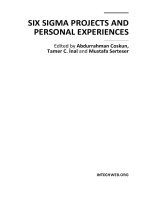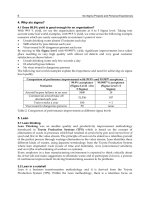Six sigma and beyond statistics and probability, volume III
Bạn đang xem bản rút gọn của tài liệu. Xem và tải ngay bản đầy đủ của tài liệu tại đây (5.32 MB, 630 trang )
SixSigmaandBeyond:Statisticsand
Probability,VolumeIII
ISBN:1574443127
byD.H.Stamatis
St.LuciePress©2003(368pages)
Thistextexplainsthetoolsofstatisticsandhow
toapplythemeffectivelytoimproveprocesses
andprofitabilityinanorganization,andalso
delineatestheimportanceofcollecting,
analyzing,andinterpretingdata.
TableofContents
SixSigmaandBeyond—StatisticsandProbability,
VolumeIII
Preface
PartI-EssentialConceptsofStatistics
Introduction
Chapter1 - DesigningandusingFormsforStudies
Chapter2 - CountingFrequencies
Chapter3 - SummarizingData
Chapter4 - WorkingwiththeNormalDistribution
TestingHypothesesAboutTwo
Chapter5 IndependentMeans
TestingHypothesesAboutTwo
Chapter6 DependentMeans
Chapter7 - ComparingSeveralMeans
Chapter8 - MeasuringAssociation
Chapter9 - CalculatingRegressionLines
Chapter10 - CommonMiscellaneousStatisticalTests
Chapter11 - AdvancedTopicsinStatistics
Chapter12 - TimeSeriesandForecasting
PartII-EssentialConceptsofProbability
Chapter13 - FunctionsofRealandRandomVariables
Chapter14 - SetTheory
Chapter15 - PermutationsandCombinations
DiscreteandContinuousRandom
Chapter16 Variables
PartIII-Appendices
AppendixA - MatrixAlgebra:AnIntroduction
AppendixB - TheSimplexMethodinTwoDimensions
AppendixC - BernoulliTrials
AppendixD - MarkovChains
AppendixE - Optimization
AppendixF - RandomizedStrategies
AppendixG - LagrangeMultipliers
AppendixH - MonteCarloSimulation
AppendixI - StatisticalReportingContent
SelectedBibliography
Index
ListofFigures
ListofTables
ListofExamples
BackCover
Researchersandprofessionalsinallwalksoflifeneed
tousethemanytoolsofferedbythestatisticalworld,
butoftendonothavethenecessaryexperienceinboth
conceptandapplication.Nomatterwhatyour
profession,soonerorlaternumbersneedtobe
crunched,andoftenyouneedtounderstandhowtodo
it,andwhyitisimportant.Qualitycontrolisno
different.SixSigmaandBeyond:Statisticsand
Probabilitycoverstheconceptsofsomeuseful
statisticaltools,appropriateformulaeforspecifictools,
theconnectionofstatisticstoprobability,andhowto
usethem.
Thisvolumeintroducestherelationshipofstatistics,
probability,andreliabilityastheyapplytoqualityin
generalandtoSixSigmainparticular.Theauthor
bringsthetheoreticalintothepracticalbyproviding
statisticaltechniques,tests,andmethodsthatthe
readercanuseinanyorganization.Hereviewsbasic
parametricandnon-parametricstatistics,probability
conceptsandapplications,andaddressestopicsfor
bothmeasurableandattributecharacteristics.He
delineatestheimportanceofcollecting,analyzing,and
interpretingdatanotfromanacademicpointofview
butfromapracticalperspective.
Thisisnotatextbookbutaguideforanyone
interestedinstatistical,probability,andreliabilityto
improveprocessesandprofitabilityintheir
organizations.Whenyoubeginastudyofsomething,
youwanttodoitwell.Youwanttodesignagood
study,analyzetheresultsproperly,andpreparea
cogentreportthatsummarizeswhatyou'vefound.Six
SigmaandBeyond:StatisticsandProbabilityshows
youhowtousestatisticaltoolstoimproveyour
processesandgiveyourorganizationthecompetitive
edge.
AbouttheAuthor
D.H.Stamatis,Ph.D.,ASQC-Fellow,CQE,CMfgE,is
currentlypresidentofContemporaryConsultants,in
Southgate,Michigan.HereceivedhisB.S.andB.A.
degreesinmarketingfromWayneStateUniversity,his
Master'sdegreefromCentralMichiganUniversity,and
hisPh.D.degreeininstructionaltechnologyand
business/statisticsfromWayneStateUniversity.
Dr.Stamatisisacertifiedqualityengineerforthe
AmericanSocietyofQualityControl,acertified
manufacturingengineerfortheSocietyof
ManufacturingEngineers,andagraduateofBSIIsISO
9000leadassessortrainingprogram.
Heisaspecialistinmanagementconsulting,
organizationaldevelopment,andqualityscienceand
hastaughtthesesubjectsatCentralMichigan
University,theUniversityofMichigan,andFlorida
InstituteofTechnology.
Withmorethan30yearsofexperiencein
management,qualitytraining,andconsulting,Dr.
Stamatishasservedandconsultedfornumerous
industriesintheprivateandpublicsectors.His
consultingextendsacrosstheUnitedStates,Southeast
Asia,Japan,China,India,andEurope.Dr.Stamatishas
writtenmorethan60articlesandpresentedmany
speechesatnationalandinternationalconferenceson
quality.Heisacontributingauthorinseveralbooks
andthesoleauthorof12books.Inaddition,hehas
performedmorethan100automotive-relatedaudits
and25preassessmentISO9000audits,andhas
helpedseveralcompaniesattaincertification.Heisan
activememberoftheDetroitEngineeringSociety,the
AmericanSocietyforTrainingandDevelopment,the
AmericanMarketingAssociation,andtheAmerican
ResearchAssociation,andafellowoftheAmerican
SocietyforQualityControl.
SixSigmaandBeyond—Statisticsand
Probability,VolumeIII
D.H.Stamatis
ST.LUCIEPRESSACRCPressCompany
BocaRatonLondonNewYorkWashington,D.C.
LibraryofCongressCataloging-in-PublicationData
Stamatis,D.H.,1947Sixsigmaandbeyond:statisticsandprobability,volumeIII
p.cm.—(SixSigmaandbeyondseries)
Includesbibliographicalreferencesandindex.
ISBN1-57444-3127
1.Qualitycontrol—Statisticalmethods.2.Productionmanagement—
Statisticalmethods.3.Industrialmanagement.I.Title.II.Series.
TS156.S732001
658.5'62—dc212001041635
CIP
Thisbookcontainsinformationobtainedfromauthenticandhighly
regardedsources.Reprintedmaterialisquotedwithpermission,and
sourcesareindicated.Awidevarietyofreferencesarelisted.
Reasonableeffortshavebeenmadetopublishreliabledataand
information,buttheauthorandthepublishercannotassume
responsibilityforthevalidityofallmaterialsorfortheconsequencesof
theiruse.
Neitherthisbooknoranypartmaybereproducedortransmittedinany
formorbyanymeans,electronicormechanical,includingphotocopying,
microfilming,andrecording,orbyanyinformationstorageorretrieval
system,withoutpriorpermissioninwritingfromthepublisher.
TheconsentofCRCPressLLCdoesnotextendtocopyingforgeneral
distribution,forpromotion,forcreatingnewworks,orforresale.Specific
permissionmustbeobtainedinwritingfromCRCPressLLCforsuch
copying.
DirectallinquiriestoCRCPressLLC,2000N.W.CorporateBlvd.,Boca
Raton,Florida33431.
TrademarkNotice:Productorcorporatenamesmaybetrademarksor
registeredtrademarks,andareusedonlyforidentificationand
explanation,withoutintenttoinfringe.
VisittheCRCPressWebsiteatwww.crcpress.com
Copyright©2003byCRCPressLLC
St.LuciePressisanimprintofCRCPressLLC
NoclaimtooriginalU.S.Governmentworks
InternationalStandardBookNumber1-57444-3127
LibraryofCongressCardNumber2001041635
PrintedintheUnitedStatesofAmerica1234567890
Printedonacid-freepaper
ToStephen
AbouttheAuthor
D.H.Stamatis,Ph.D.,ASQC-Fellow,CQE,CMfgE,iscurrently
presidentofContemporaryConsultants,inSouthgate,Michigan.He
receivedhisB.S.andB.A.degreesinmarketingfromWayneState
University,hisMaster'sdegreefromCentralMichiganUniversity,andhis
Ph.D.degreeininstructionaltechnologyandbusiness/statisticsfrom
WayneStateUniversity.
Dr.StamatisisacertifiedqualityengineerfortheAmericanSocietyof
QualityControl,acertifiedmanufacturingengineerfortheSocietyof
ManufacturingEngineers,andagraduateofBSIIsISO9000lead
assessortrainingprogram.
Heisaspecialistinmanagementconsulting,organizationaldevelopment,
andqualityscienceandhastaughtthesesubjectsatCentralMichigan
University,theUniversityofMichigan,andFloridaInstituteofTechnology.
Withmorethan30yearsofexperienceinmanagement,qualitytraining,
andconsulting,Dr.Stamatishasservedandconsultedfornumerous
industriesintheprivateandpublicsectors.Hisconsultingextendsacross
theUnitedStates,SoutheastAsia,Japan,China,India,andEurope.Dr.
Stamatishaswrittenmorethan60articlesandpresentedmany
speechesatnationalandinternationalconferencesonquality.Heisa
contributingauthorinseveralbooksandthesoleauthorof12books.In
addition,hehasperformedmorethan100automotive-relatedauditsand
25preassessmentISO9000audits,andhashelpedseveralcompanies
attaincertification.HeisanactivememberoftheDetroitEngineering
Society,theAmericanSocietyforTrainingandDevelopment,the
AmericanMarketingAssociation,andtheAmericanResearch
Association,andafellowoftheAmericanSocietyforQualityControl.
Acknowledgments
Inatypicalbook,theauthorbeginsbythankingseveralindividualswho
havehelpedtocompleteit.Inthismammothwork,somanypeoplehave
helpedthatIamconcernedthatImayforgetsomeone.
Thewritingofabookisacollectiveundertakingbymanypeople.Towrite
abookthatconveyshundredsofthoughts,principles,andwaysofdoing
thingsistrulyaHerculeantaskforoneindividual.SinceIamdefinitely
notaHerculesoraSuperman,Ihavedependedonmanypeopleover
theyearstoguidemeandhelpmeformulatemythoughtsandopinions
aboutmanythings,includingthiswork.Tothankeveryonebynamewho
hascontributedtothisworkwouldbeimpossible,althoughIamindebted
toallofthemfortheircontributions.However,someorganizationsand
individualsdostandbeyondtherest,andwithoutthem,thisserieswould
notbepossible.
SpecialthanksgotoDr.A.Stuartforgrantingmepermissiontouseand
adoptmuchofthediscussionondiscreterandomvariables,continuous
RVs,uniformandbetadistributions,functionsofrandomvariables
(tolerances),exponentialdistributionandreliability,andhypothesis
testingandOCcurvesinPartIIofthisvolume.Theworkwasadapted
fromthenotesofStatisticsandProbabilityforEngineersusedastraining
materialatFordMotorCompany.
SpecialthanksalsogotoDuxburryPressforgrantingmepermissionto
usethematerialonHolt'sModelfortrendandWinters'Modelfor
seasonalityandeconometricmodels.TheworkisbasedonManagerial
StatisticsbyS.C.Albright,W.L.Winston,C.J.ZappeandP.Kolesar,
publishedin2001.
Inaddition,specialthanksgotoPrenticeHallforgrantingmepermission
tousethematerialonthesummaryofdifferencesbetweenMANOVAand
discriminantanalysis,whatisconjointanalysis,usesofconjointanalysis,
whatiscanonicalcorrelation,andwhatisclusteranalysis.Theworkis
basedonMultivariateDataAnalysis,5thed.,byJ.F.Hair,R.E.Anderson,
R.L.Tathan,andW.C.Black,publishedin1998.
IwouldliketothankmycolleaguesDr.R.Rosa,H.Jamal,Dr.A.Crocker,
andDr.D.Demis,aswellasJ.StewartandR.Start,fortheircountless
hoursofdiscussionsinformulatingthecontentofthesevolumesintheir
finalformat.
Inaddition,IwanttothankJ.Malicki,C.Robinson,andS.Stamatisfor
theircomputerworkinpreparingsomeoftheearlierdraftsandfinal
figuresinthetext.
Iwouldliketothankasalwaysmypersonalinspiration,bouncingboard,
navigatorandeditor,Carla,forhercontinuallyenthusiasticattitudeduring
mymosttryingtimes.Especiallyforthisworkshehasdemonstrated
extraordinarypatience,encouragement,andunderstandinginputtingup
withme.
Specialthanksgototheeditorsoftheseriesfortheirsuggestionsand
improvementsofboththetextanditspresentationinthefinalformat.
Finally,mygreatestappreciationisreservedformyseminarparticipants
andthestudentsofCentralMichiganUniversitywho,throughtheirinput,
concerns,anddiscussions,havehelpedmetoformulatethesevolumes.
Withouttheiractiveparticipationandcomments,thesevolumeswould
neverhavebeenfinished.Ireallyappreciatetheireffort.
Preface
Thelong-rangecontributionofstatisticsdependsnotsomuchupon
gettingalotofhighlytrainedstatisticiansintoindustry,asitdoesin
creatingastatisticallymindedgenerationofphysicists,chemists,
engineers,andotherswhowillinanywayhaveahandindevelopingand
directingtheproductionprocessesoftomorrow.
W.A.ShewhartandW.E.Deming
Muchhasbeensaidaboutstatisticsandtheiruse.Often,though,we
statisticiansoverlookthediscussionoftheobviousassoonaswemove
awayfromtheacademicarena.Weexpectresearchersand
professionalsinallwalksoflifetousethemanytoolsofferedbythe
statisticalworld,butwehavefailedtoeducatethemappropriatelybothin
conceptandapplication.Thefocusofmoststatisticsbooksseemstobe
formulautilization.
Thisvolumewillattempttoexplainthetoolsofstatisticsandtoprovide
guidanceonhowtousethemappropriatelyandeffectively.Thestructure
ofthisworkisgoingtofollow(1)theconceptualdomainofsomeuseful
statisticaltools,(2)appropriateformulasforspecifictools,and(3)the
connectionbetweenstatisticsandprobability.
Thisvolumeisnotintendedtobeatextbook.Itisintendedtobea
generalmanualforpeoplewhoareinterestedinusingstatistical,
probability,andreliabilityconceptstoimproveprocessesandprofitability
intheirorganizations.
Thediscussionbeginswithveryelementaryissuesandprogressesto
someveryadvancedtoolsfordecision-making.Specifically,thebook
beginsbydelineatingtheimportanceofcollecting,analyzing,and
interpretingdata,fromapracticalperspectiveratherthananacademic
pointofview.Theassumptionisthatyou(thereader)areabouttobegin
astudyofsomething,andyouwanttodoitwell.Youwanttodesigna
goodstudy,analyzetheresultsproperly,andprepareacogentreportthat
summarizeswhatyouhavefound.
Becauseoftheseassumptions,thisbookdoesnotdwellonformulasand
significancetablesorproofsforthatmatter.Theassumptionisthata
statisticalsoftwarepackagewillbeutilized,andthatthereaderwill
benefitmorefromlearningtounderstandandinterprettheresults
generatedbythatsoftwarethanfrommemorizingformulas.
PartI:EssentialConceptsofStatistics
ChapterList
Chapter1:DesigningandusingFormsforStudies
Chapter2:CountingFrequencies
Chapter3:SummarizingData
Chapter4:WorkingwiththeNormalDistribution
Chapter5:TestingHypothesesAboutTwoIndependentMeans
Chapter6:TestingHypothesesAboutTwoDependentMeans
Chapter7:ComparingSeveralMeans
Chapter8:MeasuringAssociation
Chapter9:CalculatingRegressionLines
Chapter10:CommonMiscellaneousStatisticalTests
Chapter11:AdvancedTopicsinStatistics
Chapter12:TimeSeriesandForecasting
Introduction
Thisintroductionwilldiscussthebasicconceptsofallstatistics.The
intentoftheintroductionistosensitizethereadertotheimportanceof
takingstatisticsintoconsiderationinthedesignandplanningof
experiments.Unlesstheexperimenterplansastudyappropriately,
accountsforcertainissuesthatareinherentinanystudy,and
understandswhatisneededforasuccessfulexperiment,allwillbefor
naught.
WHATAREDATA?
Everythingwedoisbasedondata.So,thequestionquiteoftenis:should
thewordbedatumordata?Grammaticallyspeaking,thesingularwordis
datumandthepluralisdata.However,becausegenerallyspeakingwe
havemorethanone,theconventionisthatweusedata.Incommon
usage,dataareanymaterialsthatserveasabasisfordrawing
conclusions.(Noticethatthewordweuseis"materials."Thatisbecause
materialsmaybequantifiableornumericalandmeasurableoronthe
otherhandmaybeattributeorqualitative.Ineithercasetheycanbe
usedfordrawingconclusions.)Drawingconclusionsfromdataisan
activityinwhicheveryoneengages—bankers,scholars,politicians,
doctors,andcorporatepresidents.Intheory,webaseourforeignpolicy,
methodsoftreatingdiseases,corporatemarketingstrategies,and
processefficiencyandqualityon"data."
Datacomefrommanysources.Wecanconductourownsurveysor
experiments,lookatinformationfromsurveysotherpeoplehave
conducted,orexaminedatafromallsortsofexistingrecords—suchas
stocktransactions,electiontallies,orinspectionrecords.Butacquiring
dataisnotenough.Wemustdeterminewhatconclusionsarejustified
basedonthedata.Thatisknownas"dataanalysis."Peopleand
organizationsdealwithdatainmanydifferentways.Somepeople
accumulatedatabutdonotbothertoevaluateitobjectively.Theythink
thattheyknowtheanswersbeforetheystart.Otherswanttoexaminethe
databutdonotknowwheretobegin.Sometimespeoplecarefully
analyzedata,butthedataareinappropriatefortheconclusionsthatthey
wanttodraw.Unlessthedataarecorrectlyanalyzed,the"conclusions"
basedonthemmaybeinerror.Asuperiortreatmentforadiseasemay
bedismissedasineffectual;youmaypurchasestocksthatdonot
performwellandloseyourlife'ssavings;youmaytargetyourmarketing
campaigntothewrongaudience,costingyourcompanymillionsof
dollars;oryoumayadjustthewrongiteminaprocess,andasa
consequence,youmayaffecttheresponseofthecustomerinavery
unexpectedway.Theconsequencesofbaddataanalysiscanbesevere
andfar-reaching.Thatiswhyyouneedtoknowhowtoanalyzedatawell.
Youcananalyzedatainmanydifferentways.Sometimesallyouneedto
doisdescribethedata.Forexample,howmanypeoplesaytheyare
goingtobuyanewproductyouareintroducing?Whatproportionofthem
aremenandwhatproportionarewomen?Whatistheiraverageincome?
Whatproductcharacteristicisthecustomerdelightedwith?Inother
situations,youwanttodrawmorefar-reachingconclusionsbasedonthe
datayouhaveathand.Youwanttoknowwhetheryourcandidatestands
achanceofwinninganelection,whetheranewdrugisbetterthanthe
oneusuallyused,orhowtoimprovethedesignofaproductsothatthe
customerwillbereallyexcitedaboutit.Youdonothaveallofthe
informationyouwouldliketohave.Youhavedatafromsomepeopleor
samples,butyouwouldliketodrawconclusionsaboutamuchlarger
audienceorpopulation.
Atthisjunctureyouranswermaybe,"Idonothavetoworryaboutallthis
becausethecomputerwilldoitforme."Thatisnotanabsolutetruth.
Computerssimplifymanytasks,includingdataanalysis.Byusinga
computertoanalyzeyourdata,yougreatlyreduceboththepossibilityof
errorandthetimerequired.Learningaboutcomputersandpreparing
dataforanalysisbycomputerdorequiretime,butinthelongrunthey
substantiallydecreasethetimeandeffortrequired.Usingacomputer
alsomakeslearningaboutdataanalysismucheasier.Youdonothaveto
spendtimelearningformulas.Thecomputercandothecalculatingfor
you.Instead,youreffortcangointothemoreinterestingcomponentsof
dataanalysis—generatingideas,choosinganalyses,andinterpreting
theirresults.
Becausecalculationsarethecomputer'sjob,notyours,thisvolumedoes
notemphasizeformulas.Itemphasizesunderstandingtheconcepts
underlyingdataanalysis.Thecomputercanbeusedtocalculateresults.
Youneedtolearnhowtointerpretthem.
DESCRIBINGDATA
Onceyouhavepreparedadatafile,youarereadytostartanalyzingthe
data.Thefirststepindataanalysisisdescribingthedata.Youlookatthe
informationyouhavegatheredandsummarizeitinvariousways.You
countthenumberofpeoplegivingeachofthepossibleresponses.You
describethevaluesbycalculatingaveragesandseeinghowmuchthe
responsesvary.Youlookatseveralcharacteristicstogether.Howmany
menandhowmanywomenaresatisfiedwithyournewproduct?What
aretheiraverageages?Youalsoidentifyvaluesthatappeartobe
unusual,suchasagesintheonehundredsorincomesinthemillions,
andyouchecktheoriginalrecordstomakesurethatthesevalueswere
pickedupcorrectly.Youdonotwanttowastetimeanalyzingincorrect
data.
TESTINGHYPOTHESES
Sometimesyouhaveinformationavailableforeveryoneoreverything
thatyouareinterestedindrawingconclusionsabout,andallyouneedto
doissummarizeyourdata.Butusuallythatisnotthecase.Instead,you
usuallywanttodrawconclusionsaboutmuchlargergroupsofpeopleor
objectsthanthoseincludedinyourstudy.Youwanttoknowwhat
proportionofallpurchasersofyourproductaresatisfiedwithit,basedon
theopinionsoftherelativelysmallnumberofpurchasersincludedinyour
survey.Youwanttoknowwhetherbuyersofyourproductdifferfrom
nonbuyers.Aretheyyounger,richer,bettereducated?Youwanttobe
abletodrawconclusionsaboutallbuyersandnonbuyersbasedonthe
peopleyouhaveincludedinyourstudy.
Todothis(andunderstandit),youhavetolearnsomethingabout
statisticalinference.Laterchaptersinthisvolumewillshowyouhowto
testhypothesesanddrawconclusionsaboutpopulationsbasedon
samples.Youwilllearnhowtotestwhetheryouhavesufficientevidence
tobelievethatthedifferencesorrelationshipsyoufindinyoursampleare
trueforthewholepopulation.
DESCRIBINGRELATIONSHIPS
Youoftenwanttodeterminewhattherelationshipisbetweentwo
variables.Forexample,whatistherelationshipbetweendollarsspenton
advertisingandsales?Howcanyoupredicthowmanyadditionalsalesto
expectifyouincreaseyouradvertisingbudgetby25%?Whatisthe
relationshipbetweenthedosageofadrugandthereductioninblood
pressure?Howcanyoupredicttheeffectonbloodpressureifyoucutthe
doseinhalf?Youcanstudyandmodeltherelationshipbetweenpairsof
variablesinmanydifferentways.Youcancomputeindexesthatestimate
thestrengthoftherelationship.Youcanbuildamodelthatallowsyouto
predictvaluesofonevariablebasedonthevaluesofanother.Thatis
whatthelastpartofthebookisabout.
Youmuststateyourideasclearlyifyouplantoevaluatethem.This
adviceappliestoanykindofworkbutespeciallytoresearchdesignand
statisticalanalysis.Beforeyoubeginworkingondesignandanalysis,you
needtohaveaclearlydefinedtopictoinvestigate.
ASKINGAQUESTION
Youmayhaveageneralsuspicionthatsmokinglessmakespeoplefeel
better.YoumaythinkthatcomponentAisbetterthancomponentB.Or
youmayhaveanideaforastudymethodthatwillmakepeoplelearn
more.Beforeyoubeginastudyaboutsuchintuitions,youshouldreplace
vagueconceptssuchas"feelingbetter"or"smokingless"or"learning
more"withdefinitionsthatdescribemeasurementsthatyoucanmake
andcompare.Youmightdefine"better"withaspecificperformance
improvementorareductioninfailure.Youmightreplace"feelingbetter"
withanobjectivedefinitionsuchas"thesubjectexperiencesnopainfora
week."Oryoumightrecordtheactualdosageofmedicationrequiredto
controlpain.Ifyouareinterestedinsmoking,youneedalotof
informationtodescribeit.Whatdoeseachofthesubjectssmoke—a
pipe,cigars,orcigarettes?Howmuchtobaccodothesubjectsuseina
day?Howlonghavetheybeensmoking?Hasthenumberofcigarettes
(orcigarsorpipes)thattheysmokechanged?
Ontheotherhand,youmustbalanceyourscientificcuriositywiththe
practicalproblemsofobtaininginformation.Ifyoumustrelyonpeople's
memory,youcannotaskquestionslike"Whatdidyouhavefordinnerten
yearsago?"Youmustaskquestionsthatpeoplewillbeabletoanswer
accurately.Ifyouaretryingtoshowarelationshipbetweendietand
disease,forexample,youcannotrelyonpeople'smemoryofwhatthey
ateatindividualmeals.Instead,youhavetobesatisfiedwithoverall
patternsthatpeoplecanrecall.Someinformationissimplynotavailable
toyou,howevermuchyouwouldliketohaveit.Itisbettertorecognize
thisfactbeforeyoubeginastudythanwhenyougetyourquestionnaires
backandfindthatpeoplewerenotabletoansweryourfavoritequestion.
Ifyouthinkaboutyourtopicinadvance,youcansubstituteabetter
question—onethatwillgiveyouinformationyoucanuse,evenifitisnot
theinformationyouwishyoucouldhave.
WHATINFORMATIONDOYOUNEED?
Acriticalstepinthedesignofanystudyisthedecisionaboutwhat
informationyouaregoingtorecord.Ofcourse,youcannotrecordevery
possiblepieceofinformationaboutyoursubjectsandtheirenvironment.
Therefore,youshouldthinkhardaboutwhatinformationyouwilltryto
get.Ifyouaccidentallyforgettofindoutaboutanimportantcharacteristic
ofyoursubjects,youmaybeunabletomakesenseofthepatternsyou
findinyourdata.Whenindoubt,itisusuallybettertorecordmore
informationthanless.Itiseasytoleaveunnecessaryvariablesoutof
yourdataanalysis,butitisoftendifficult(andexpensive)togobackand
gatheradditionalinformation.Forexample,ifyouarestudyingwhattypes
ofpeoplearelikelytobuyahigh-pricednewproduct,youmaynotbe
abletoadequatelycomparebuyerswithnonbuyersifyouforgetto
includeinformationaboutincome.
DEFININGAPOPULATION
Whenyouconductastudy,youwantyourconclusionstobefar-reaching.
Ifyouareapsychologystudent,youmaywantyourresultstoapplytoall
laboratoryrats,notjusttheonesinyourlab.Similarly,ifyouaredoinga
marketresearchsurveyonwhetherpeopleinLosAngeleswouldbuy
disposableumbrellas,youmaywanttodrawconclusionsabout
everybodyinthecity.Ifyouareanengineerandyouareinvolvedinthe
developmentofaparticularproduct,youwanttoknowwhatkindofa
baseorpopulationtheproductisfor.Thepeopleorobjectsaboutwhom
youwanttodrawconclusionsarecalledapopulation.
Oneoftheearlystepsinanystudyisnailingdownexactlywhatyouwant
yourpopulationtobe.Themoredefiniteyouareindefiningpopulations,
thebetteryourunderstandingofsamplesandtheresultsofyourstudy
willbe.
Definingapopulationmayseemstraightforward,butoftenitisnot.
Supposethatyouareacompanypersonnelmanager,andyouwantto
studywhypeoplemisswork.Youprobablywanttodrawconclusionsonly
aboutemployeesinyourparticularcompany.Yourpopulationiswell
defined.However,ifyouareagraduatestudentwritingadissertation
aboutthesametopic,youfaceamuchmorecomplicatedproblem.Do
youwanttodrawconclusionsaboutprofessionals,laborers,orclerical
staff?Aboutmenorwomen?Whichpartoftheworldisofinterest—a
city,acountry,ortheworldasawhole?Nodoubt,you(andyouradvisor)
wouldbedelightedifyoucouldcomeupwithanexplanationfor
absenteeismthatwouldapplytoallsortsofworkersinallsortsofplaces.
Youarenotlikelytocomeupwiththatkindofexplanation,though.Even
ifyoudo,youarenotlikelytocomeupwiththeevidencetosupportit.
Allkindsofpeoplemissworkbecausetheyaresick,butunlikeothers,
thepresidentofMajorCorporationprobablydoesnotneedtostayhome
waitingforaphonetobeinstalled.Theafternoonshetakesofftoplay
golfwithhisbuddiesareprobablynotrecordedbythepersonnelofficeas
absenteeism,either.Peoplemissworkforlotsofreasons,andthe
reasonsarequitedifferentfordifferentkindsofemployees.Berealistic
andstudyonlyapartofthelaborforce.Absenteeismamonglaborersin
autofactoriesinDetroit,forexample,isaproblemwithawell-defined
populationaboutwhichyouwouldhaveafightingchancetodrawsome
interestingconclusions.
DESIGNINGASTUDY
Evenwhenthepopulationofinterestseemstobewelldefined,youmay
notactuallybeabletostudyit.Ifyouareevaluatinganewmethodfor
weightloss,youwouldideallyliketodrawconclusionsabouthowwellit
worksforalloverweightpeople.Youcannotreallystudyalloverweight
people,though,orevenagroupthatistypicalofalloverweightpeople.
Peoplewhodonotwanttoloseweightorwhohavebeendisheartened
bypasteffortstoreducemaynotagreetotryyetanothermethod.You
willprobablybeabletotryoutyournewmethodonlyonpeoplewhowant
toloseweightandwhohavenotgivenuptrying.Thesepeople,notall
overweightpeople,formyourpopulation.
Rememberthatapopulationdefinedrealisticallyinthiswaymaybe
differentfromtheidealpopulation.Forexample,thepopulationinyour
weightlossstudymaybelighter,younger,orhealthierthantheideal
populationofalloverweightpeople.Therefore,yourconclusionsfrom
studyingpeoplewhowanttoloseweightdonotnecessarilyapplyto
peoplewhoarenotmotivated.Forexample,thetreatmentmayhave
someunpleasantconsequences,suchasmakingpeoplewanttochew
onthenearestthingavailable,suchasgum,apencil,orthecornerofa
desk.Peoplewhoreallywanttoloseweightmaybewillingtoputupwith
suchminorinconveniencesinordertoreachtheirgoal.Peoplewhodo
notcaremuchabouttheirweightprobablywillnotbe.Thus,thenew
treatmentmayworkquitedifferentlyforthosewhoaremotivatedversus
thosewhoarenot.









